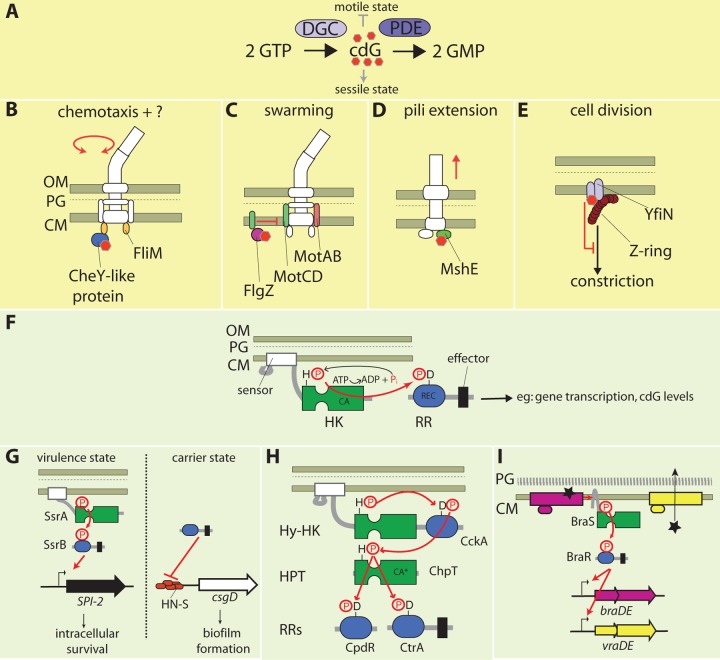FIG 3.
Intracellular signaling variations. (A) Control of cyclic di-GMP (cdG) levels in a cell. Diguanylate cyclase (DGC) proteins synthesize cdG (red hexagons) from two GTP molecules, while phosphodiesterase (PDE) proteins facilitate its degradation to GMP. (B to E) cdG targets discussed in BLAST XIII; see the text for details. (B) A novel CheY-like protein in C. crescentus directly binds to cdG, causing its localization to FliM. (C) FlgZ bound to cdG sequesters MotC (green ovals), preventing its incorporation into the stator in P. aeruginosa. (D) cdG directly binds to the type IV pilus extension ATPase, MshE, to stimulate pilus production in V. cholerae. (E) cdG may cause the DGC YfiN to alter its conformation, inducing its interaction with FtsZ (maroon circles) in order to prevent Z-ring constriction. (F) A paradigm two-component signal (TCS) transduction system. Signal transmission occurs via His-Asp phosphorelay between conserved His kinase (HK; green) and receiver (REC; blue) modules connected by polypeptide linker regions (gray lines). In response to activation by the sensor domain, the HK module autophosphorylates on an invariant His (H) residue after hydrolysis of ATP by the catalytic (CA) domain. The phosphoryl group (P) is donated to an invariant Asp (D) in the REC module that activates the associated DNA binding effector domain to modulate gene transcription. Effector domains may instead encode enzymatic domains, such as diguanylate cyclases. (G to I) Variations of the paradigm TCS system discussed in BLAST XIII; see the text for details. (G) The S. enterica SsrA/B system in which the phosphorylated form of the RR SsrB (SsrB-P) regulates Salmonella pathogenicity island 2 (SPI-2). Unphosphorylated SsrB antagonizes the H-NS nucleoid protein to derepress csgD. (H) The multistep CckA-ChpT-CtrA-CpdR His-Asp phosphorelay system of Brucella abortus, in which a phosphoryl group is transmitted via a REC module in a hybrid histidine kinase (Hy-HK) to a histidine phosphotransferase (HPT) protein. The phosphoryl group is then transferred to either of two response regulators to mediate outputs. CA*, degenerate CA domain. (I) The S. aureus BraSR system in which the HK BraS is activated upon direct interaction with the BraE permease (pink rectangle) when its ligand bacitracin (star) is bound. BraR-P induces expression of a second permease system (yellow rectangle and circle) which then exports the bacitracin. CM, cytoplasmic membrane; PG, peptidoglycan; OM, outer membrane.

